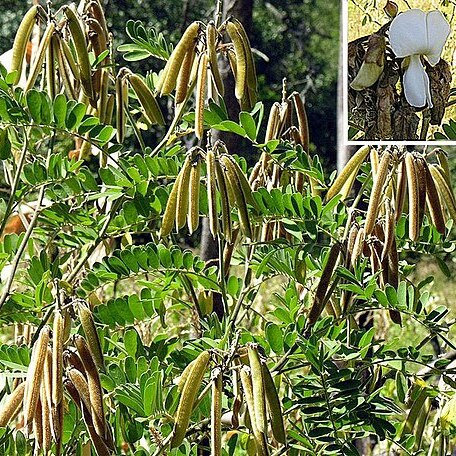A softly woody branching herb 1–4 m. tall; stem tomentose with both short and long white or fulvous hairs.. Leaf-rhachis 10–25 cm. long, including a petiole of 1–3 cm., prolonged 2–7 mm. beyond lateral leaflets; stipules tomentose, very caducous, lanceolate, 1–2 cm. long; leaflets 13–29, elliptic-oblong or elliptic-oblanceolate, up to 5 by 2 cm., silky tomentose above and more densely so beneath, the nerves very obscure above.. Flowers white or, less often, violet in dense terminal or sometimes axillary rusty tomentose pseudoracemes; peduncles stout, at least 2.5 mm. in diameter, ± as long as pseudoraceme; bracts caducous, ovate-acuminate, up to 12 by 9 mm.; pedicels up to 23 mm. long.. Calyx brown tomentose; tube ± 4 mm. long; 2 upper lobes oblong, united almost to tip, rounded at apex, ± 6 mm. long; lateral lobes oblong, rounded at tip, ± 7 by 4 mm.; lower lobe narrow, boat-shaped, acute, ± 10 mm. long.. Standard white silky, ± 23 mm. long by 25 mm. wide; keel pubescent at the margins.. Upper filament lightly attached, strongly dilated ± 2 mm. above the base; filament-sheath ±19 mm., free parts 4–8 mm., anthers 1.7 mm. long.. Style bent through ± 70° 2 mm. above the base, in all ± 10 mm. long, shortly pubescent on both sides, incurved at the tip.. Pod straight, horizontal, densely white or, especially at the sutures, rusty tomentose, ± 110 by 13 by 4 mm., beak straight or slightly down-curved.. Seeds 12–16, black, smooth, oval, obliquely transverse, ± 7 by 4.5 by 3 mm.; hilum at side of narrower end, with a well-marked annular aril.
Herbs, perennial, erect, many branched. Stems tomentose with short and long white and yellow trichomes, trichomes ca. 1.5 mm. Leaves 13-29-foliolate; rachis 10-25 cm, including petiole 1-3 cm; leaflet blades oblong-elliptic to lanceolate-elliptic, 3-7 × 0.9-1.8 cm, abaxially densely mixed white and yellow tomentose, adaxially appressed white sericeous, secondary veins 12-15 on each side of midvein. Pseudoracemes terminal or axillary near apex of branchlets, 10-15 cm, rusty tomentose, long pedunculate. Pedicel 2-2.3 cm, rusty villous. Flowers ca. 2.5 cm. Calyx ca. 1.2 × 1 cm, brown tomentose; teeth oblong, ca. 1 cm, apex rounded but adaxial one narrowly acute. Corolla white or occasionally violet; standard orbicular, sericeous. Ovary sericeous, with numerous ovules. Legume linear, 10-13 cm × 12-14 mm, straight, yellowish white tomentose, rusty on suture, apex beaked. Seeds 12-16 per legume, black, broadly ovoid, ca. 7 × 4.5 mm, smooth. Fl. and fr. year-round. 2n = 22.
Soft, woody, branching herb, up to 2 m high; stem tomentose with both short tawny and long white hairs. Leaves imparipinnate, rachis up to 250 mm long. Leaflets 13-29, ± 48 x 15 mm, elliptic-oblong or elliptic-oblanceolate; upper surface silky tomentose; lower surface more densely tomentose and nerves silky hairy. Stipules caducous, lanceolate, tomentose. Inflorescences terminal or axillary, pseudoracemes with flowers densely arranged at apex; peduncles and axes rusty-tomentose, becoming silvery at apex. Flowers white or violet, pedicels brown-tomentose. Calyx brown-tomentose. Petals: standard white silky. Flowering time Aug? Pod linear, up to 140 x 18 mm, woolly to sericeous. Seeds 6-18, ellipsoid to reniform.
Leaves with (6)8–13(15) pairs of leaflets; petiole 9–28 mm long, petiole and rachis together (9)11–22(27) cm long, tomentose like the stem; leaflets 2.5–5.5(7.5) × (0.6)0.9–1.7(2.3) cm, elliptic-oblong to oblanceolate, rounded to cuneate at the base, rounded to emarginate at the apex, slightly mucronate, the upper surface rather thinly appressed-pubescent, the lower surface densely appressed-pubescent; stipules 11–20 × 2.5–4.5 mm, narrowly triangular or sometimes markedly falcate, soon falling.
A softly woody herb. It is a branched shrub. It grows 1-4 m high. The stems are covered with dense hairs. The leaves have 13-29 leaflets. These are oblong and 5-9 cm long by 2-3 cm wide. They have silky hairs on top. The flowers are about 2.7 cm long in dense stalked clusters. The flowers can be white or violet. The fruit are 10-14 cm long pods which are 1.2-1.7 cm wide. They are densely hairy. The hairs near the edges are rusty brown and the ones towards the centre are white.
Flowers in dense heads up to 10(20 in fruit) cm, or the lowermost sometimes somewhat remote; bracts up to 16 × 13 mm, broadly ovate-acuminate to suborbicular-acuminate, brown or greyish tomentose, conspicuous at bud stage but soon falling as flowers open; pedicels 14–26 mm long, brown tomentose.
Calyx 14–20(24) mm long, brown or greyish tomentose; upper and lateral teeth about twice as long as the tube, oblong, ± truncate at the apex, the lower tooth about 1.5 times as long as the lateral, strongly grooved and upwardly curved distally into a keel-like shape.
Petals white, rarely the standard purple; standard 24–30(34) mm long, truncate to strongly cordate at the base, the wings and keel petals somewhat shorter.
Seeds numerous (more than 15), 6–8 × 4–4.5 × 2–2.5 mm, black, smooth, with a well developed white U-shaped aril c.2 mm long.
Upper stamen loosely attached to, and easily detachable from, the adjacent stamens about the middle of the filament.
Stems brown tomentose with long flexuous hairs intermixed among shorter and denser spreading hairs.
Flowers conspicuous, red or red-purple, in dense racemes
Pods 9–14.5 × 1.3–1.7 cm, light brown lanate-tomentose.
Shrub 1–3(4) m high, usually much branched and bushy.
Clothed with dense yellowish or rusty tomentum
Ovary tomentose; style pubescent.
An erect shrub 6–10 ft. high


